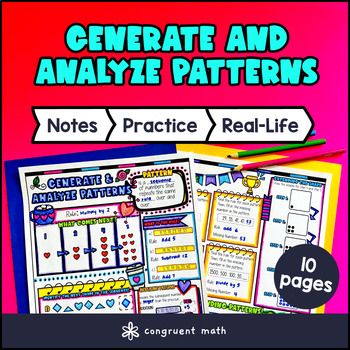Want more ideas and freebies?
Get my free resource library with digital & print activities—plus tips over email.
Join for Free Resources →
$4.25
Ever wondered how to teach patterns in an engaging way to your 4th grade students?
In this lesson plan, students will learn about generating and analyzing number patterns and shape patterns and their real-life applications. Through artistic, interactive guided notes, checks for understanding, a doodle and color by number activity, and a maze worksheet, students will gain a comprehensive understanding of number patterns.
The lesson ends with a real-life example that explores how social media algorithms and movie recommendation systems apply pattern recognition and rules in everyday technology.

$4.25
After this lesson, students will be able to:
Before this lesson, students should be familiar with:
As a hook, ask students if they have ever noticed repeating patterns in things around them, such as shapes on wallpaper or the rhythm in music. Then, prompt them to think about why recognizing these patterns might be useful in everyday life. Refer to the last page of the guided notes for the real-life application example involving pattern generations, and see the FAQs below for additional ideas on engaging students with this discussion.
Use the first page of the guided notes to introduce the concept of generating number and shape patterns. Walk through how patterns are created by following specific rules, emphasizing identifying what changes from one element to the next and how a consistent rule applies to each step. Use the visual doodles to help illustrate the concept of adding or multiplying to build an increasing pattern or using subtraction or division to build a decreasing pattern. Refer to the FAQ below for a detailed walk-through on explaining these ideas and suggestions for addressing common student questions about what constitutes a pattern and how to identify the rule.
Use the second page of the guided notes to introduce analyzing and extending patterns by finding missing elements and determining the rule governing the pattern. Focus discussion on strategies for finding the missing number or shape, such as checking differences or ratios between elements and testing possible rules. Highlight the guided notes’ questions and practice prompts that check students’ understanding of these strategies. Look to the FAQ below for guidance on supporting students who struggle with recognizing the rule or filling in missing parts of the pattern.
Based on student responses during these initial guided notes discussions and checks for understanding, reteach any concepts or strategies that students find challenging. For example, some may need additional examples of identifying the rule, or more practice distinguishing between additive and multiplicative patterns. If your class has a range of proficiency levels, consider pulling small groups for reteaching targeted skills while more advanced students start the practice worksheets that follow. This targeted support will ensure all students build a solid foundation in generating and analyzing number patterns.
Have students practice generating and analyzing number patterns using the maze activity worksheet provided in the resource (page 3). Walk around to answer student questions.
Fast finishers can dive into the color by code activity (page 4) for extra practice. You can assign it as homework for the remainder of the class.
Bring the class back together, and introduce the concept of social media algorithms, movie recommendation systems, and how they use patterns recognitions to show us content we like. Explain that patterns help computers decide which posts to show next based on what we've liked or interacted with before. Refer to the FAQ for more ideas on how to teach it!
If you’re looking for digital practice for generating and analyzing number patterns, try my Pixel Art activities in Google Sheets. Every answer is automatically checked, and correct answers unlock parts of a mystery picture. It’s incredibly fun, and a powerful tool for differentiation.
Here’s 2 activities to explore:
A number pattern is a sequence of numbers that follows a particular rule or formula, allowing you to predict the next numbers in the sequence.
To generate a number pattern, you start with a first number and apply a consistent rule, such as adding or multiplying by a fixed amount, to find each subsequent number in the sequence.
Analyzing number patterns means examining the sequence to determine the rule or formula that creates it. This helps in predicting future numbers and understanding the relationship between terms.
Common types of number patterns for 4th graders include:
To find the rule of a number pattern, observe how the numbers change from one term to the next. Then:
Learning number patterns is important because it helps students develop critical thinking and problem-solving skills. It also lays the foundation for understanding algebra and mathematical relationships in everyday life.
Real-life examples show how patterns apply outside the classroom, making concepts easier to grasp. For example:
Activities that help practice number patterns include:
Get my free resource library with digital & print activities—plus tips over email.
Join for Free Resources →